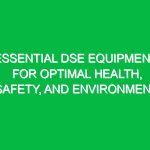In today’s fast-paced industrial landscape, the importance of equipment maintenance cannot be overstated, especially within the context of Health, Safety, and Environment (HSE) practices. Effective equipment maintenance ensures not only the longevity and efficiency of machinery but also plays a crucial role in safeguarding the health and safety of workers and the environment. This article delves into essential equipment maintenance tips that are vital for achieving HSE success.
Understanding Equipment Maintenance in the HSE Context
Equipment maintenance refers to the activities undertaken to keep machinery and tools in optimal working condition. This includes regular inspections, repairs, and replacements of parts to prevent breakdowns and ensure safety. Within the HSE framework, equipment maintenance is critical because poorly maintained equipment can lead to accidents, injuries, and environmental damage.
For instance, consider a manufacturing plant where a conveyor belt system is not regularly inspected. If the system fails due to wear and tear, it could not only halt production but also pose significant risks to workers nearby. Such scenarios highlight why a proactive approach to equipment maintenance is essential.
Key Aspects of Equipment Maintenance Relevant to HSE
1. Regular Inspections and Audits
One of the cornerstones of effective equipment maintenance is conducting regular inspections and audits. These assessments help identify wear and tear, potential hazards, and compliance with safety standards. An example of this can be seen in the oil and gas industry, where equipment such as pumps and valves undergo routine inspections to prevent leaks and spills that could harm the environment.
2. Scheduled Preventive Maintenance
Preventive maintenance involves routine checks and services performed on equipment to prevent unexpected failures. This approach can significantly reduce the likelihood of accidents and costly repairs. For example, a construction company might implement a preventive maintenance schedule for its heavy machinery, including regular oil changes, filter replacements, and system checks. This proactive strategy not only enhances safety but also extends the lifespan of the equipment.
3. Training and Competence of Personnel
Ensuring that personnel are adequately trained in equipment operation and maintenance is crucial. Workers should understand the specific maintenance procedures for the equipment they operate. For instance, in a chemical processing plant, operators must be trained to follow proper protocols for handling and maintaining equipment to prevent chemical spills that could endanger lives and the environment.
4. Use of Technology
Incorporating technology into equipment maintenance practices can greatly enhance efficiency and safety. For example, predictive maintenance uses data analytics and sensors to monitor equipment performance in real-time. This technology can alert maintenance teams before a failure occurs, allowing for timely interventions. A manufacturing facility that employs predictive maintenance may find that it significantly reduces downtime and enhances worker safety.
5. Documentation and Record Keeping
Maintaining detailed records of all maintenance activities is vital for compliance and safety audits. Documentation should include inspection results, repair logs, and maintenance schedules. This not only helps in tracking the equipment’s condition but also demonstrates compliance with HSE regulations. A healthcare facility, for instance, must keep comprehensive records of maintenance performed on medical equipment to ensure they are safe and effective for patient care.
Potential Hazards and Risks in Equipment Maintenance
While the goal of equipment maintenance is to enhance safety, it can also pose risks if not managed properly. Here are some potential hazards:
- Mechanical Hazards: Improper maintenance can lead to equipment malfunctions, which may cause injuries to operators or nearby personnel.
- Chemical Exposure: In industries where chemicals are involved, inadequate maintenance of containment systems can result in leaks and exposure to harmful substances.
- Ergonomic Risks: Maintenance tasks may expose workers to ergonomic hazards, such as lifting heavy components or working in awkward positions.
To mitigate these risks, it is essential to conduct risk assessments and implement safety protocols during maintenance activities.
Best Practices for Equipment Maintenance in HSE
1. Develop a Comprehensive Maintenance Plan
A structured maintenance plan tailored to the specific needs of the equipment and the operational environment is crucial. This plan should outline all maintenance tasks, frequencies, and responsible personnel. For instance, a mining company may create a detailed maintenance plan for its drilling equipment that includes daily checks, monthly servicing, and annual overhauls.
2. Foster a Safety-First Culture
Creating a culture that prioritizes safety is essential for successful equipment maintenance. Employees should be encouraged to report any safety concerns or equipment malfunctions immediately. Regular safety meetings can reinforce this culture and ensure that everyone is aware of their responsibilities regarding equipment maintenance.
3. Engage in Continuous Improvement
Regularly reviewing and improving maintenance processes is necessary to adapt to new challenges and technologies. For example, a facility might implement a lean maintenance strategy that emphasizes efficiency and waste reduction, leading to better resource allocation and enhanced safety outcomes.
4. Collaborate with Equipment Manufacturers
Working closely with equipment manufacturers can provide valuable insights into maintenance best practices. Manufacturers often have specific guidelines and recommendations that can enhance the longevity and safety of their equipment. For example, if a manufacturing plant collaborates with its machinery supplier, it may gain access to training resources and updated maintenance protocols that improve overall safety.
Regulations and Standards Governing Equipment Maintenance
Compliance with regulations and standards is a critical aspect of equipment maintenance in the HSE context. Various organizations and government bodies establish guidelines to ensure safety and environmental protection.
1. OSHA Standards
The Occupational Safety and Health Administration (OSHA) sets forth standards for workplace safety, including equipment maintenance. Employers are required to ensure that equipment is properly maintained to prevent accidents and injuries. Compliance with OSHA regulations not only protects employees but also shields organizations from legal repercussions.
2. ISO Standards
The International Organization for Standardization (ISO) provides a framework for effective equipment maintenance through standards like ISO 55000, which focuses on asset management. Adhering to these standards can help organizations optimize their maintenance processes and enhance safety outcomes.
3. Environmental Regulations
Environmental regulations, such as the Environmental Protection Agency (EPA) guidelines, dictate how equipment should be maintained to prevent environmental harm. Compliance with these regulations is essential to avoid penalties and protect natural resources.
Conclusion
In summary, effective equipment maintenance is a critical component of HSE success. By implementing regular inspections, preventive maintenance, and ensuring proper training, organizations can significantly reduce risks and enhance workplace safety. Additionally, compliance with relevant regulations and a commitment to continuous improvement will foster a culture of safety and environmental stewardship.
As industries continue to evolve, the importance of robust equipment maintenance practices cannot be overlooked. Organizations must prioritize these practices not only to comply with regulations but to protect their most valuable asset—their people. By doing so, they contribute to a safer, healthier, and more sustainable work environment for all.


